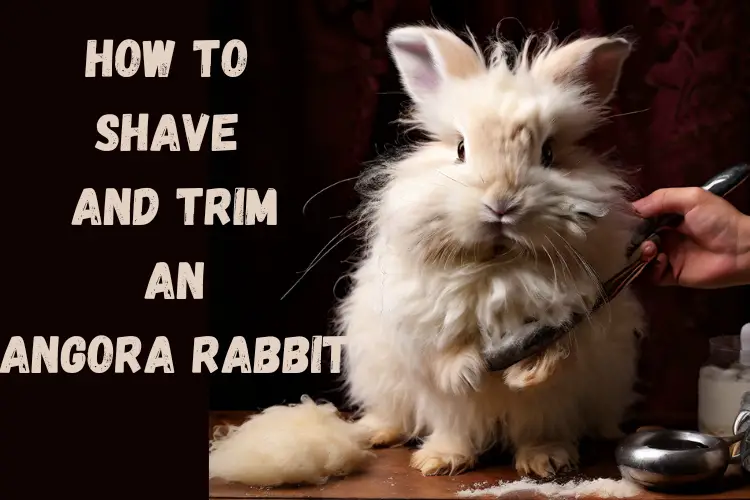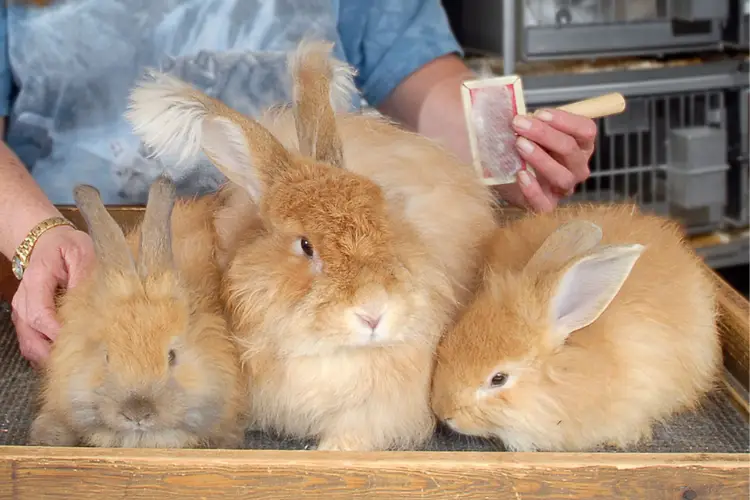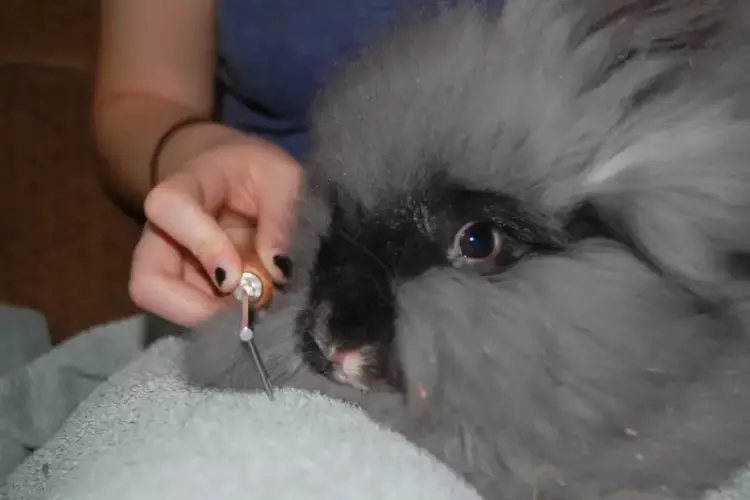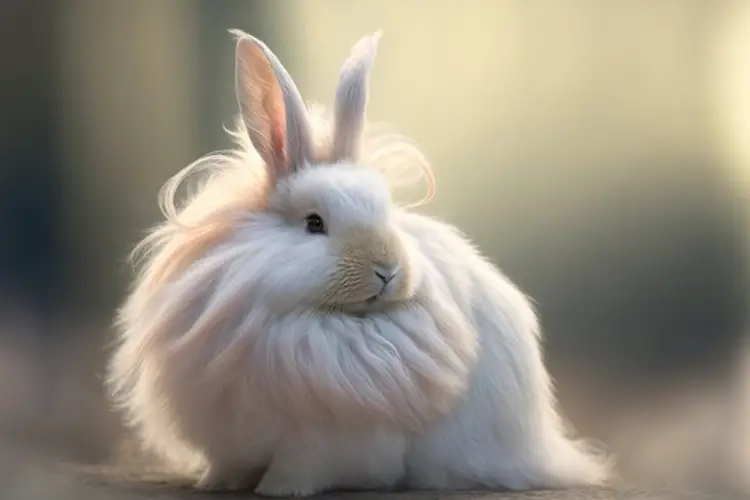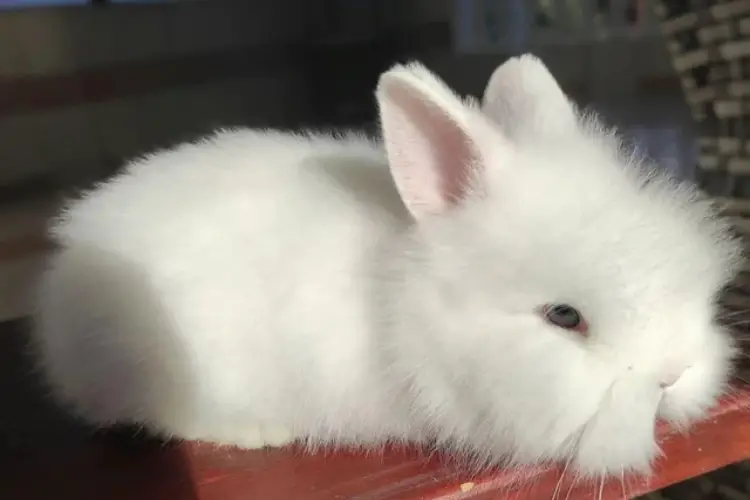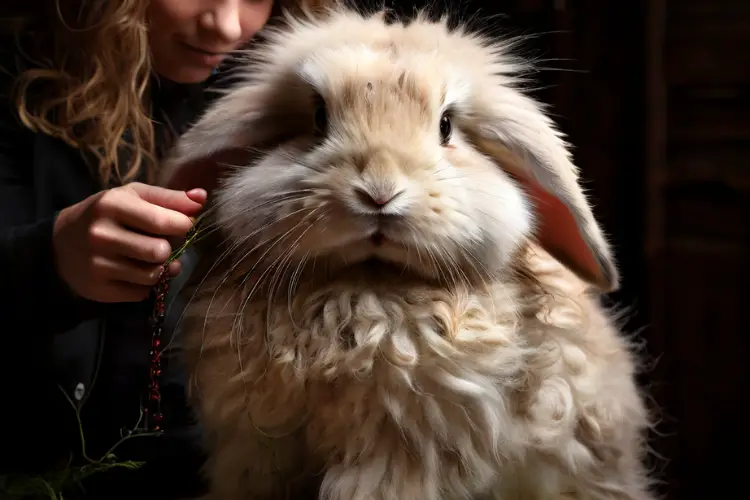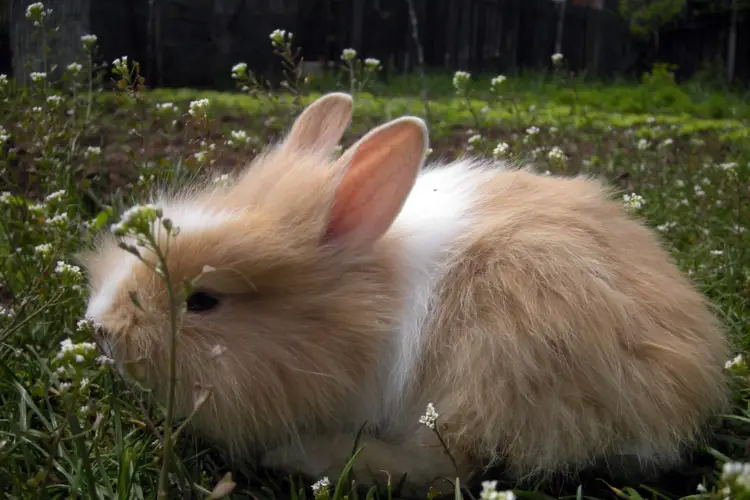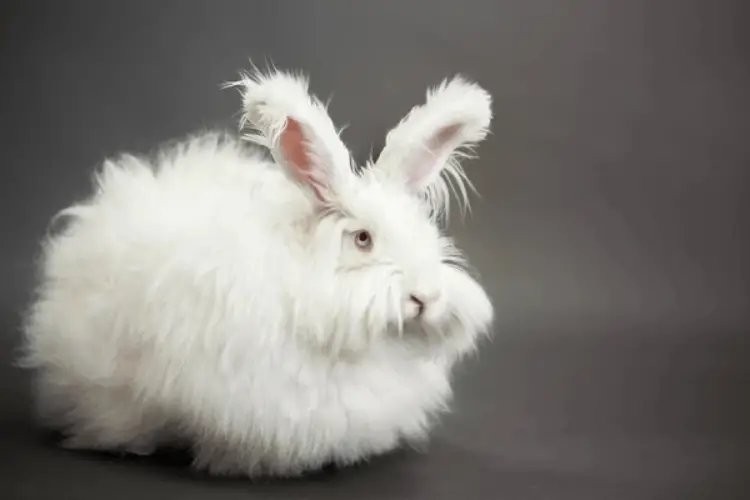Grooming an Angora rabbit is an essential part of their care, ensuring their long, luxurious fur remains in good condition and their overall health is maintained.
In this blog post guide, we will give you a comprehensive guide on how to shave and trim an Angora rabbit, covering everything from preparation to post-grooming care. With the right tools and techniques, you can keep your Angora rabbit looking and feeling their best.
Key Takeaways
- Regular grooming is crucial for Angora rabbits, with brushing needed weekly and more frequently during shedding seasons.
- Creating a calm environment and using the right grooming tools, like electric clippers with ceramic cutter heads, can make the process smoother.
- Trimming and shaving should be done carefully to avoid pulling the hair or hurting the rabbit, especially around sensitive areas like ears.
- Health checks during grooming are vital to prevent issues such as flystrike, and knowing when to seek veterinary care is important for your rabbit’s wellbeing.
- Post-grooming care includes ensuring hygiene, monitoring behavior for any signs of distress, and maintaining a regular grooming schedule.
Preparing Your Angora Rabbit for Grooming
Understanding Your Rabbit’s Grooming Needs
Angora rabbits are renowned for their luxurious fur, which requires regular maintenance to keep them healthy and comfortable.
Grooming is not just about aesthetics; it’s a vital aspect of their well-being. Angoras need grooming at least twice a month, but aiming for a weekly routine is better to prevent matting and ensure their coat remains in good condition.
When considering the grooming requirements of an Angora, it’s crucial to understand that their thick fur can lead to serious health issues if not properly managed. They can suffer from a condition called wool block, where ingested fur accumulates in their digestive system, potentially leading to fatal consequences.
Regular grooming helps to minimize the risk of wool block by removing loose fur that they might otherwise ingest during self-cleaning.
Here are some essential points to remember about Angora rabbit grooming:
- Their long fur can quickly become matted if not brushed regularly.
- Avoid bathing your rabbit, as they are self-cleaning and baths can be stressful.
- Pay special attention to their ears, which are crucial for regulating body temperature, and keep them clean.
- Trim their toenails as needed to prevent overgrowth and injury.
Creating a Calm Environment
The secret to perfect grooming is not just about the right tools or techniques; it’s about creating a serene atmosphere that puts your Angora rabbit at ease.
Start by choosing a quiet spot where your rabbit feels comfortable and safe from loud noises and disturbances. This could be a familiar room or a secluded area where they spend most of their time.
Minimize stress by maintaining a gentle demeanor and using soft, reassuring tones when speaking. It’s also helpful to have a routine in place, as rabbits are creatures of habit. Consistency in grooming sessions can help your rabbit know what to expect and feel more relaxed during the process.
Here’s a simple checklist to ensure a calm environment:
- Find a quiet, safe location
- Speak in soft, soothing tones
- Establish a consistent grooming routine
Remember, a calm rabbit is more likely to stay still, making the grooming session safer and more enjoyable for both of you.
Gathering Necessary Grooming Tools
Before you begin the grooming session, it’s crucial to have all the necessary tools at hand. Proper preparation will ensure a smooth and stress-free experience for both you and your Angora rabbit. Start by assembling a grooming kit that caters to the unique needs of your rabbit’s luxurious coat.
The cornerstone of your grooming toolkit should be a high-quality brush. An 8-in-1 Rabbit Grooming Kit is a comprehensive choice, as it includes a variety of tools such as a Double-Layer Needle Slicker Brush and a Rubber Tip Shampoo Bath Glove Brush with an adjustable ring handle.
Additionally, a Double-Tooth Stainless comb can be invaluable for detangling and removing loose fur without causing discomfort to your rabbit.
Remember to keep your grooming tools clean and in good condition to prevent any potential health issues. Regular maintenance of these tools is as important as the grooming process itself.
The Grooming Process
Brushing Techniques for Angora Rabbits
Proper brushing is essential for maintaining the health and appearance of your Angora rabbit’s luxurious coat. Start with a wide-toothed comb to gently detangle the fur, working in sections from the bottom up to avoid pulling on the skin. Transition to a finer brush to smooth out the coat and remove any remaining loose fibers.
When brushing, be mindful of the rabbit’s comfort. Use soft, gentle strokes and take breaks if your rabbit becomes restless. Here’s a simple guide to the brushing frequency based on your rabbit’s coat condition:
- Daily brushing is recommended during shedding periods to prevent matting.
- Weekly brushing may suffice for rabbits with less dense coats or during non-shedding times.
Always inspect the skin for signs of irritation or parasites as you groom. If you notice any abnormalities, consult with a veterinarian promptly. Remember, regular brushing not only keeps your rabbit looking its best but also strengthens the bond between you and your pet.
Trimming the Fur: Step-by-Step
Trimming the fur of your Angora rabbit is a delicate process that requires patience and the right tools. Ensure your rabbit is comfortable and still before you begin the trimming process.
Use electric clippers designed for pets, which often come with various attachments to control the length of the cut. It’s essential to choose clippers with a safe rounded corner design to prevent harming your rabbit’s skin.
Begin with the larger guard combs to remove the bulk of the fur, and then switch to shorter combs for a closer trim. Here’s a simple guide to the comb sizes:
- 3 mm comb: For a light trim, maintaining some fur length
- 6 mm comb: Ideal for a medium trim, balancing between length and hygiene
- 9 mm comb: To tackle longer fur, especially during shedding season
- 12 mm comb: For the longest trim, usually suitable for colder months
Remember to frequently check the skin for any signs of irritation or cuts. If your rabbit’s condition seems to worsen, consult your vet immediately. After trimming, gently brush the rabbit to remove any loose fur and ensure a smooth coat.
Ear and Nail Care Essentials
Proper ear and nail care are crucial for maintaining your Angora rabbit’s health and comfort. Regularly check your rabbit’s ears for any signs of dirt, wax buildup, or parasites. Gently clean the ears with a soft cloth and a vet-approved ear cleaning solution. Avoid inserting anything into the ear canal to prevent injury.
When it comes to nail trimming, use a pair of sharp, small animal nail clippers. Trim just the tips of the nails to avoid cutting into the quick, which can cause bleeding and pain. If you accidentally cut the quick, have styptic powder or a similar product on hand to stop the bleeding. Here’s a simple guide to follow:
- Inspect the nails and identify the quick
- Position the clippers at a safe distance from the quick
- Clip the tips of the nails
- Smooth the edges with a nail file if necessary
Remember, patience and gentle handling are key to a stress-free grooming experience for your rabbit.
Health and Safety During Grooming
Identifying and Preventing Flystrike
Flystrike is a severe and often fatal condition that affects rabbits, particularly during warmer months. Prevention is crucial, as the condition can lead to death within hours of onset. To prevent flystrike, ensure your rabbit’s living area is always clean and dry. Regularly check for any signs of injury or soiling, as these can attract flies.
When grooming, pay special attention to your rabbit’s hygiene. Trim any soiled fur and clean the skin thoroughly. In some cases, it may be necessary to shave the fur to allow for better air circulation and easier monitoring of the skin’s condition.
Always use caution when applying any sprays or treatments, avoiding sensitive areas such as the eyes and nose, and consult a vet if you’re unsure.
Here are some additional steps to help prevent flystrike in your rabbit:
- Keep the hutch clean and free of waste.
- Change bedding regularly to avoid dampness.
- Monitor your rabbit’s diet to ensure healthy digestion and minimal soiling.
- Consider using fly repellents specifically designed for rabbits, following all safety guidelines.
Recognizing When to Seek Veterinary Care
While regular grooming is essential for your Angora rabbit’s health, it’s crucial to recognize when professional veterinary care is needed. If your rabbit exhibits any unusual symptoms or behaviors, such as loss of appetite, lethargy, or changes in bathroom habits, it may indicate a health issue that requires immediate attention.
Some common health concerns for Angora rabbits include:
- Dental problems due to overgrown teeth
- Gastrointestinal stasis, a potentially life-threatening condition
- Respiratory infections
- Skin infections or parasites
It’s important to maintain a relationship with a veterinarian who is experienced with rabbits. They can provide preventive care, diagnose and treat illnesses, and offer guidance on the specific needs of your Angora rabbit. Remember, early detection and treatment can make a significant difference in your rabbit’s health and well-being.
Avoiding Common Grooming Mistakes
When grooming your Angora rabbit, it’s crucial to avoid common pitfalls that could harm your pet or cause discomfort. Never shave your rabbit, as their fur is essential for regulating body temperature and protecting their sensitive skin. Instead, focus on regular brushing and trimming to manage their long fur.
Be mindful of the grooming tools you select. A proper grooming kit should include a cleaning brush, nail clippers, and a safe pair of scissors for trimming.
Avoid using clippers designed for other animals, as they may be too powerful and cause injury. Always refer to the instruction manual to ensure you’re using each tool correctly.
Lastly, remember that rabbits are self-cleaning animals and do not require baths. Bathing can lead to a stressful experience and potentially cause health issues. Keep their living space clean and monitor their self-grooming habits to maintain their hygiene.
Post-Grooming Care and Maintenance
Ensuring Proper Hygiene After Grooming
Maintaining the hygiene of your Angora rabbit after grooming is crucial for their health and comfort. Immediately after grooming, it’s important to check for any loose fur that may have been missed and could cause digestive issues if ingested. Use a soft brush to gently remove any remaining hairs.
When it comes to cleaning your rabbit, remember that full baths are generally not recommended. Rabbits are self-cleaning animals and can become highly stressed during a bath. Instead, spot cleaning is a safer alternative.
Strive to only wet the specific area that needs cleaning. For example, if it’s just their leg, dip it into a bucket of lukewarm water and quickly remove it. Dry the area thoroughly to prevent hypothermia or skin issues.
Lastly, ensure that your rabbit’s living space is clean and dry. Replace bedding with fresh material and sanitize any grooming tools used. This will help prevent the spread of bacteria and maintain a healthy environment for your rabbit.
Monitoring Your Rabbit’s Behavior
After grooming, it’s crucial to observe your Angora rabbit’s behavior for any signs of stress or discomfort. Changes in behavior can indicate potential health issues or a negative reaction to the grooming session. Look for signs such as reluctance to move, changes in eating habits, or unusual vocalizations.
Post-grooming, rabbits may exhibit certain behaviors as they readjust to their clean coat. It’s important to ensure that your rabbit is comfortable and returning to its normal routine. Here’s a simple checklist to help you monitor your rabbit’s post-grooming behavior:
- Normal activity level and playfulness
- Regular eating and drinking habits
- Usual interaction with you and other rabbits
- Consistent grooming of itself
If you notice any persistent changes, it’s essential to consult with a veterinarian. Monitoring your rabbit’s behavior helps in early detection of issues, which can be crucial for the well-being of your Angora rabbit.
Scheduling Regular Grooming Sessions
After completing a grooming session, it’s crucial to establish a routine to maintain your Angora rabbit’s coat and overall well-being. Regular grooming sessions are essential to prevent matting, reduce shedding, and ensure your rabbit’s fur remains in good condition.
Aim to schedule grooming at least once a week, with more frequent sessions during shedding periods.
To keep track of your grooming schedule, consider maintaining a grooming calendar. This can help you stay organized and ensure that your rabbit’s grooming needs are met consistently. Here’s a simple example of how you might structure your grooming calendar:
- Monday: Brushing
- Wednesday: Nail trimming
- Friday: Ear cleaning
- Sunday: Full grooming session
Remember, the frequency of grooming may vary based on your rabbit’s specific needs and the time of year. Always be gentle and patient during grooming, as rabbits have delicate skin. Lastly, keep an eye out for any signs of distress or discomfort, which could indicate a need for a veterinary visit.
Additional Tips for Angora Rabbit Care
Exercise and Playtime Recommendations
Angora rabbits require ample exercise and playtime to maintain their health and happiness. Every day, dedicate 2-3 hours for your rabbit to play in a safe, enclosed outdoor space like a garden or park. This not only helps them burn off energy but also provides essential mental stimulation.
When allowing your rabbit to play outdoors, it’s crucial to monitor them closely. Predators or other dangers can pose a risk to your small-sized companion. To ensure their safety, consider supervised playtime or a secure playpen.
In addition to outdoor play, indoor exercise is important. Create a rabbit-proof area inside your home where your Angora can explore and play.
This can include tunnels, hideouts, and toys designed for rabbits. Remember, playtime is not just about physical exercise; it’s also an opportunity for bonding and interaction, which is vital for your rabbit’s well-being.
Creating a Comfortable Living Space
Creating a comfortable living space for your Angora rabbit is crucial for its well-being. Ensure an area of the hutch is separated from the rest and that it is completely dark, mimicking the safety of a burrow. This will serve as a retreat for your rabbit to rest and feel secure.
Provide plenty of bedding so that your Angora can get comfortable and burrow. Bedding materials should be soft, absorbent, and safe if ingested.
Avoid cedar and pine shavings, as they can cause liver damage and respiratory issues in rabbits. Instead, opt for materials like aspen shavings, paper-based products, or hay.
Regular cleaning of the living space is essential to prevent the buildup of ammonia from urine, which can be harmful to your rabbit’s respiratory system. Here’s a simple cleaning routine:
- Remove soiled bedding daily.
- Wipe down surfaces with a rabbit-safe disinfectant weekly.
- Perform a deep clean of the entire hutch monthly.
Understanding Potty and Walking Training
Training your Angora rabbit in potty and walking habits is essential for a harmonious living situation. Potty training should begin at a young age to take advantage of your rabbit’s developing habits.
By consistently placing droppings in the litter box within their living space, your rabbit will learn to associate the scent and location with the appropriate place to relieve itself.
Walking your rabbit on a leash may seem unconventional, but it’s a great way to provide exercise and mental stimulation. Start with short, supervised sessions in a safe, enclosed area. Gradually, as your rabbit becomes accustomed to the leash, you can explore more expansive environments together.
Remember, patience and consistency are key when training your Angora rabbit. Here’s a simple checklist to help you stay on track:
- Acquire a suitable size cage or hutch
- Introduce the litter box early on
- Use droppings to reinforce potty training
- Begin leash training in a secure area
- Gradually increase walking distances
By following these steps and maintaining a routine, your rabbit will learn to trust and understand the expectations, leading to a more enjoyable experience for both of you.
Conclusion
Shaving and trimming an Angora rabbit requires a gentle touch and the right tools to ensure the comfort and safety of your furry friend. Throughout this article, we’ve explored the essential steps and considerations for proper grooming, from selecting the appropriate clippers to understanding the rabbit’s grooming needs.
Remember, regular grooming not only keeps your rabbit looking its best but also prevents health issues such as flystrike and matting. By following the advice provided, including the importance of exercise and avoiding baths, you can maintain your Angora rabbit’s luxurious coat while ensuring they remain happy and healthy.
Whether you’re a seasoned rabbit owner or new to the world of Angora rabbits, the insights and tips shared here will help you master the art of grooming your pet with confidence and care.
FAQs:
How often should I groom my Angora rabbit?
Angora rabbits require regular grooming. Brushing should be done several times a week, and trimming should occur every few months or as needed to prevent matting and overheating.
Is it okay to bathe my Angora rabbit?
It’s generally advised against bathing rabbits, as they are self-cleaning and bathing can be a stressful experience. Spot cleaning with a damp cloth can be done if necessary.
What kind of grooming tools do I need for my Angora rabbit?
You’ll need a slicker brush, a fine-toothed comb, scissors or clippers designed for small animals, a nail clipper, and a quiet, electric pet shaver clipper for thicker fur.
Can I use any clippers for trimming my Angora rabbit’s fur?
No, you should use clippers that are specifically designed for small animals with thick fur, such as Angora rabbits. Clippers with a fine tooth ceramic cutter head are recommended for a smooth and safe trimming experience.
What should I do if I notice signs of flystrike on my rabbit?
Flystrike is a medical emergency. If you notice any signs, such as eggs or maggots on your rabbit’s skin, seek veterinary care immediately to prevent serious health issues or death.
How much exercise does my Angora rabbit need?
Angora rabbits, like other small-sized rabbits, need plenty of exercise to maintain their health. Providing 2-3 hours of playtime in a safe, predator-free environment daily is essential.

